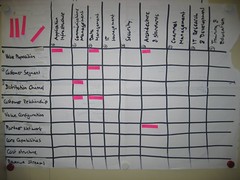
- Image by Alex Osterwalder via Flickr
In the last 10 years, I have seen a common theme in fortune 500 organizations in regards to Content Management Systems (CMS) and-or Web Content Management (WCM) solutions. Many CMS projects begin with a misalignment between the objectives of the business (Marketing, Finance, Operations, Silos, Product Groups) and information technology. It is essential that a CMS/WCM solution be started with all parties having common and clear set objects and performance measure for CMS success. CMS initiatives should always reflect an organizations long term business strategy (Internet, extranet and intranet etc…). However, more often than not, the CMS reflects a general interpretation of business needs by I.T. Why would I say this? To start, most CMS initiatives begin to assuage a general need across the company.
For Example:
“The business would like shorter time to market for web content change and decrease the need and dependency of resources from I.T.”
“The organization would like to reuse and share content across the organization and gain efficiencies and reduce duplication of effort across departments.”
Do these sound familiar? Well this is common sales pitch for a CMS. However, these needs are typically paired up with vague performance measures that quickly attempt to define measure for ROI and before you know it, you have a CMS budget and the project begins.
According to Gartner’s atricle “Tactical Guidelines for Narrowing Your Choices When Evaluating WCM Vendors” from December 2008:
1. More than 65% of the Web Content Management teams were unaware of their organizations’ high-level, nontechnical objectives.
2. More than 95% of Web Content Management related inquiries involved teams that had not identified specific, measurable metrics for their WCM initiatives.
This research validates my professional experiences and points to an overwhelming trend in companies that enterprise level CMS/WCM projects are executed without clearly identifying the needs/wants of the business and the key performance indicators of success. In fact, many CMS/WCM projects are designed and executed from a technical point of view within information technology communities. Information Technology groups are measured by ROI of their systems and resources shared across the organization. I.T. traditionally tries to develop a “general” CMS solution that can be shared across the organization as to achieve economies of scale in content management and support resources. For example, many WCM initiatives revolve around solutions that allow business units to leverage
- Generic Presentation Templates for HTML/JSP/ASPX Generation
- Generic Content Types and Metadata
- Generic Tag Libraries or APIs for integration with legacy systems
However, this “one size fits all solutions” directly or indirectly conflicts with the expectations of business units that are moving toward a more segmented/targeted solutions that deal with customers at a more granular level. Many business units interact with the web and see all the new technologies dealing with Analytics, Segmentation, Targeting, AJAX, Flash, Silverlight, Video, JavaScript, Facebook, Social Media, and RSS. The business units then ask the internal I.T. group on the time and effort required to get these features into the CMS/WCM solutions. What is the result…. push-back!!!
Why do they get push-back?
- The key performance measures of I.T. conflict with the business needs of the client.
- I.T. focuses on centralization, support, and reuse while the business units wants segmented, targeted, and custom solutions.
- I.T. just spent 2-5 years developing a CMS infrastructure to meet the requirements of five years ago and architecture cannot support current needs that demand quick, agile, custom across multiple distributions channels.
- The current infrastructure is just now getting return on investment and the CTO/CIO are under pressure to squeeze every last dollar out the current infrastructure before significant improvements are made or rebuilt.
- Traditional I.T. projects require 6-12 months before customizations and modifications can be brought online.
- Most enterprise CMS/WCM vendors (Microsoft, Interwoven/Autonomy, FileNet, Documentum, Oracle) move just as slow as internal I.T. organizations in delivering more relevant and rich feature sets to meet current and future needs. Therefore the CMS vendor architecture itself cannot support the business requirement (Now I know most vendors will directly disagree with this statement, but its true)
- Due to this push-back, many business units tend to see their internal CMS controlled by I.T. efforts as slow moving, difficult to use, and political. As a result, we see growth in software and as a service (SAAS) solutions being leveraged by business units, such as marketing, to go around their internal information technology departments. This is especially prevalent in situations dealing with social media, user submitted content, and moderation.
In order to prevent and-or lessen these issues in regards to CMS initiatives, it is essential to create and develop a cross-department CMS team that has a common set of high level non-technical business objective agreed upon. These objective must be measurable and have specific targets to measured against. Once done, technology and business will be on common ground for successful cross-organization CMS experience.
![Reblog this post [with Zemanta]](http://img.zemanta.com/reblog_e.png?x-id=bb648627-6ae9-4108-bd88-fd9ee4a80e51)
Hi, nice posts there thank’s concerning the gripping advice
thank’s concerning the gripping advice